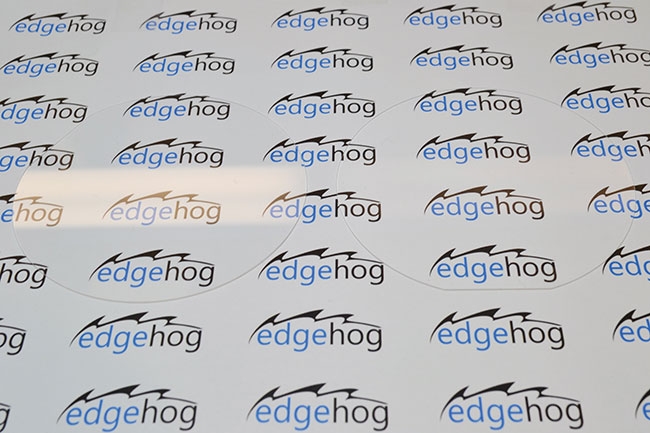
Technology
Glass
The eye of the moth – nanoscale glass etching achieves non-reflection and superhydrophobicity
A Montreal tech startup looks to commercialize bio-inspired nano-textured glass.
September 24, 2018 By Calvin Cheng co-founder and product lead Edgehog
 Left: Regular glass showing glare from ceiling light. Right: Edgehog antireflective glass, featuring clearly visible background graphics.Edgehog achieves this non-reflective surface without coatings or films, and the surface is non-reflective from almost all angles.
Left: Regular glass showing glare from ceiling light. Right: Edgehog antireflective glass, featuring clearly visible background graphics.Edgehog achieves this non-reflective surface without coatings or films, and the surface is non-reflective from almost all angles. Nano-sized modification on the surface of glass brings huge reductions in the reflection of light and keeps the glass water-repellant and clean. Invented at Brookhaven National laboratory in New York, the technology is now being commercialized by a team of entrepreneurs based in Montreal. Applied to architectural glass and solar panels, the broad-spectrum technology promises to achieve an unparalleled look of invisible glass, increased energy conversion in panels and self-cleaning properties for outdoor glass.
New innovations in functionalized glass is revolutionizing industries, but anti-reflective glass remains elusive. A wave of new innovations in glass is sweeping through many industries. Consumers are seeing new functionalities throughout their daily lives such as anti-scratch cell phone displays, interactive holographic projections on transparent screens, smart windows and many more. However, one inherent property of glass continues to irk designers. The reflection of light, or glare, ruins the visual experience in all such applications. Especially in transportation applications, safety can be compromised.
Reflection arises out of abrupt changes in the index of refraction as light travels between the air and glass. This four per cent reflection at each interface is omnipresent. There exist several technologies to address the challenge, but none have yet adequately addressed all applications.
Micro-structured “anti-glare” glass is a time-honoured technique for blurring and decreasing glare. By scattering light in all directions, less light is reflected to the viewer. However, the micro-structures also blur visuals, rendering them unsuitable for storefront windows, mobile phone screens and other applications where clarity is required.
Another mature approach, optically interfering thin films, eliminates the reflection at a narrow band of wavelength. With film thicknesses at half or a quarter of the targeted wavelength, light is transmitted rather than reflected. However, the reflected colour changes with the angle of viewing and, even with multiple layers, the ideal flat spectral response or broad wavelength anti-reflection cannot be achieved. Finally, because such films are often softer than the substrate and chemically and thermally different, they are susceptible to peeling and damage from environmental exposure or wear-and-tear.
Bio-inspired nanostructures
In the biological evolution race, nocturnal moths have evolved anti-reflective eyes and wings to escape detection by predators. By growing sub-wavelength nanostructures on smooth surfaces, light throughout the visible and near infra-red wavelengths is absorbed. One can imagine these structures as densely packed pyramids with sub-100-nanometer lateral dimensions and over 200 nanometers vertical depth. From the perspective of light, such small size scales cannot be perceived. As a result, no light is scattered.
In these nano-sized “moth-eye” patterns, an originally flat interface between air and the material is replaced with a fuzzy layer of pyramids. There is a gradual change in the index of refraction from the top of the pyramids to the bottom, which characterizes the essence of moth-eye patterns. Because the abrupt change in the index of refraction from glass to the material is replaced with a gentle index gradient, all wavelengths of light are transmitted through the pattern.
Learning from moths, scientists at Brookhaven National Lab successfully reproduced this bio-pattern on the surface of glass. Applied to both sides of glass, the nano-features render the glass almost invisible. With more than a decade of research and advances in manufacturing techniques, the moth-eye glass is now ready to take centre stage. Working in Montreal, a team of technology entrepreneurs at Edgehog is scaling up this innovation for mass adoption.
Currently manufactured at relatively small size scales, Edgehog is making anti-reflective glass for sensor windows, small displays for smart phones and watches and specialty solar panels. As a transmissive window, the Edgehog glass allows more than 99.8 per cent transmission of visible light. Importantly, the spectral transmission is uniform throughout the entire wavelength range and can be tuned for near-infra-red regions. Used for display covers, the Edgehog glass eliminates unwanted reflection, enabling improved screen readability even in sunlight or other bright conditions. With a flat spectral response, the colour of the display image remains unchanged despite wide viewing angles. In solar panels, greater energy conversion is achieved by increasing the amount of visible and near-infrared light entering the solar cell.
Superhydrophobicity
A complementary effect of the Edgehog glass is the superhydrophobic self-cleaning property. Inspiration once again comes from the bio-world: the superhydrophobic leaf of a lotus plant floats on the surface of water and as waves wash over the lotus leaf debris and contamination is continuously washed off. Here, the nanostructures again play a critical role. Water droplets on the small surface protrusions act much like a performance artist walking over a bed of needles. The surface tension of water keeps droplets disposed on top of the needles rather than sinking into them and the droplets easily roll off the surface.
With the self-cleaning property of the solar panel surfaces, the Edgehog technology prevents the typical 25 per cent decrease in performance resulting from months of fouling in outdoor conditions. Applied on windows, labour-intensive and costly cleaning processes are largely avoided.
Print this page